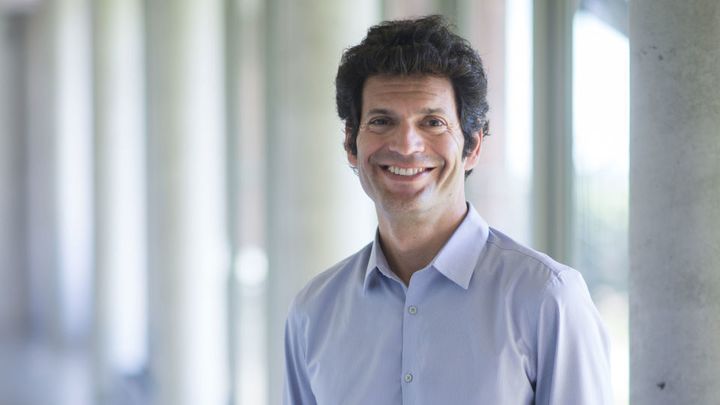Former Kripalu CEO David Lipsius shares how he plans to support the yoga community through this period of exceptional growth and change at Yoga Alliance's helm.

In mid-May, Yoga Alliance, the largest international nonprofit association promoting and supporting the yoga community, welcomed former Kripalu CEO David Lipsius as its new President and CEO. Lipsius has been a registered yoga teacher since 2006, and has studied and practiced yoga for nearly 20 years. He also has leadership experience in marketing, media, and entertainment, as well as a doctor of law (JD) degree from Brooklyn Law School in New York. We caught up with Lipsius to find out what he has in store for Yoga Alliance and to get his thoughts on how the yoga community can and should grow, change, and give back going forward, including moving toward a “gold standard” for yoga teachers and schools.
Yoga Journal: You've been President and CEO of Yoga Alliance for a month and a half now. What types of changes have you made so far? What are your short- and long-term goals for YA? David Lipsius: Appropriate, conscious, and exciting change is coming, but only after careful review of the issues and responsible consideration of input from our members. However, before going further, let me say how grateful I am to be at Yoga Alliance and Yoga Alliance Registry [a public charity that sets voluntary standards for yoga teacher training programs and credentials]. I am deeply appreciative of the opportunity to serve our registered yoga teachers and schools who are working with great effort and success every day to help other human beings become healthier, happier, and more connected to themselves and others. I am also grateful to be in a position to initiate significant and necessary change for the benefit of the public.
In my early days at Yoga Alliance, I have placed a priority on finding ways to serve individuals and communities who have been underserved to date and initiated the development of an inclusive process for evaluating the current teacher and school standards. Our plans also include efforts to unite our community on shared projects that will increase the positive social impact of yoga educators, and we have committed to deepening Yoga Alliance’s investment in continuing education and advocacy on behalf of teachers and schools. Also, because I have witnessed the long-term damage that can be done to students when outlier yoga teachers and schools violate ethical and scope of practice standards, Yoga Alliance will work with experts to develop new protocols and standards that will assist the field as it shifts into an era of safety, inclusion, and sensitivity appropriate for a more sophisticated and enlightened age of yoga.
I also would like to share that we have hired a new Chief Operating Officer, Shannon Roche, to help serve our community. While I will share more about Shannon and our other leadership team members in the coming weeks, our entire staff will ensure Yoga Alliance is exceptionally well-managed, fiscally responsible as a not-for-profit, and that all actions and activities come from a heart-based desire to serve the public and our teachers and schools.
YJ: What kind of wisdom would you like to bring to Yoga Alliance from Kripalu? DL: Yoga Alliance and Kripalu are very different entities, but they share two core traits that are vitally important to me in my work as a not-for-profit leader. First, they are both not-for-profit organizations that wanted to significantly improve, evolve, and increase their social impact. Second, they were both interested in introducing a shift toward mission-driven service. As for wisdom, I can share that as the leader of Kripalu for five years, I was able to spend quality face time with thousands of yoga teachers, school owners, practitioners, industry leaders, thought leaders, donors, and even a few disgruntled yogis. It is their shared wisdom, extensive insights into yoga, and advice that I bring with me to Yoga Alliance and their interests, concerns, hopes, and intentions that I strive to represent. As we move forward, I believe that truly serving others vs. serving ourselves is the new frontier of yoga teaching, and I intend to support those who are taking this moonshot for a better world through dedicated, committed, and passionate service.
YJ: How do you plan to help the yoga community extend its social impact, and make yoga more inclusive and more accessible to all? DL: First, I would like to acknowledge and appreciate the thousands of registered yoga teachers and others who already make a positive social impact every day through their chosen work. While they may not get the praise they deserve, we see them, appreciate them, and want to highlight their efforts. As an organization, Yoga Alliance, through our Foundation, will also seed and support additional initiatives that introduce yoga to underserved populations and geographic regions, and will form relationships with like-minded individuals and organizations to exponentially reach more people in need of the benefits of yoga.
YJ: Tell us why the Yoga Alliance mission resonated with you. DL: As a practitioner of yoga since 1999, yoga teacher since 2006, and recent CEO of Kripalu Center, I am intimately familiar with the modern evolution of yoga and have investigated the eras that preceded my involvement. While quietly studying yoga and the yoga industry, I have heard people—with deep emotion—expressing love, passion, anger, and frustration directed at all manner of schools, lineages, media companies, manufacturers, websites, retreat centers, for-profit companies and not-for-profit entities like us. As part of my service as a yoga teacher, I decided to roll up my sleeves and join one of the few organizations that has a very tangible and real opportunity to make positive change in the industry on behalf of all yogis. And, I’d like to see whether Yoga Alliance’s leadership might also inspire other not-for-profit and for-profit companies to join us to make positive change as well. The opportunity is vastly appealing to me, and my sense is that there are millions of sincere yogis out there who want to be part of the solution. I believe it is time we started supporting, celebrating, and maximizing all of the great work of the yoga teachers and schools that are giving back and doing good, and because Yoga Alliance is non-partisan and non-denominational, we are able to balance our support universally among all yogas in their amazing diversity.
YJ: Do you plan to offer yoga teacher training directly through Yoga Alliance, in a similar fashion to the 1,000-hour YTT you developed at Kripalu? DL: As shared with our membership, in essential collaboration with knowledgeable and accomplished yogis both within and outside of Yoga Alliance, we will conduct a top to bottom review of the current yoga teaching standards in relation to the challenges and opportunities that face our schools and teachers. In due course, with expert help, we will develop a plan to evolve the standards that have been in place for over a decade and move to a gold standard we can all share and support to ensure public safety and professional excellence. This is different from, and vastly more important than, offering a Yoga Alliance YTT directly at this time.
YJ: How has Yoga Alliance changed in recent years as far as offering more transparency regarding the qualifications of its teachers? DL: From my vantage point, Yoga Alliance has always attempted to be transparent in communicating standards and qualifications for yoga teachers and schools, as those are the primary tools to protect the public interest. But there is always room for improvement in communication clarity, style, and content, and I look forward to doing things differently. I think you’ll find a new effort moving forward. For example, the present efforts to evaluate and strengthen standards and education as core areas of focus will be fully transparent and communicated clearly as the plans and partners develop, and will reflect the thoughts, guidance, and collective wisdom of the global yoga community.
YJ: How has Yoga Alliance changed its standards in recent years for registered yoga teachers (RYTs), registered yoga schools (RYSs), and Yoga Alliance Continuing Education providers (YACEPs)? Do you feel YA has been criticized in the past for not raising standards enough? DL: Yes, I am aware of the criticism, and thank you for asking an important question that allows us to put the subject in context. Yoga Alliance, and perhaps the yoga industry as a whole, has a responsibility to naturally, systematically, and intelligently evolve and adapt as the public interest in yoga continues to grow. The issue of standards and credentials is a constantly evolving equation, and it is therefore important to be objective, mindful, and balanced as we move forward. That being said, what worked 17 years ago may or may not be sufficient moving forward; the existing standards were created in another time, with an entirely different set of facts at play (there were fewer than 50 registered yoga schools in the year 2000). It is therefore time to reevaluate the standards, and Yoga Alliance has now begun that project, which will be inclusive, open, and intelligently designed. Yoga Alliance is prepared to work with great partners and wisdom-holders to ensure best outcomes. It is also important to remember, however, that the number of hours in a teacher training program, while vitally important, is only part of the equation. For those interested in improving and protecting yoga, we must functionally address the other serious issues that threaten the integrity of yoga, such as individual teachers abusing their power, or individual schools using non-ethical practices. When reflected in the full spectrum of challenges and opportunities facing our community, the exact number of hours spent on anatomy in a YTT becomes a somewhat secondary equation in relation to the overall integrity and diversity of yoga. Solutions will require a united effort and a real commitment, which we are prepared to offer.
YJ: Yoga Alliance has a responsibility to represent the yoga community, so that it can practice and teach yoga freely. What are the most important regulatory issues currently facing the yoga community? How does Yoga Alliance plan to continue working with U.S. government agencies to oppose unnecessary regulation? DL: For those who are not yet aware, with the exponential growth of yoga across the U.S., we have seen some state governments turn their attention toward yoga teacher training programs and providers, seeking to levy fees and impose requirements that can be inappropriate for these programs and services. Specifically, some states have attempted to regulate yoga teacher training programs like career or vocational schools. Other states and jurisdictions have considered expanding sales and use taxes on yoga studios and considered legislation that could inadvertently affect the yoga community. State advocacy efforts on these types of issues over the past few years—initiated by Yoga Alliance and participated in by our members—is perhaps the most meaningful development in modern yoga in the last 20 years.
While Yoga Alliance understands that some regulation is important and beneficial, the organization has long recognized the risks of unnecessary, overly burdensome, and unfair regulations targeted at yoga businesses and providers. For this reason, Yoga Alliance has taken a leadership role in advocating for our members to prevent hardships to those who serve the public through yoga. We have been involved in significant advocacy initiatives in 10 states, partnering with passionate and knowledgeable members to support thriving yoga communities. Yoga Alliance plans to continue its important advocacy efforts, and we need your help to stay informed and aware of what is happening in your state.
